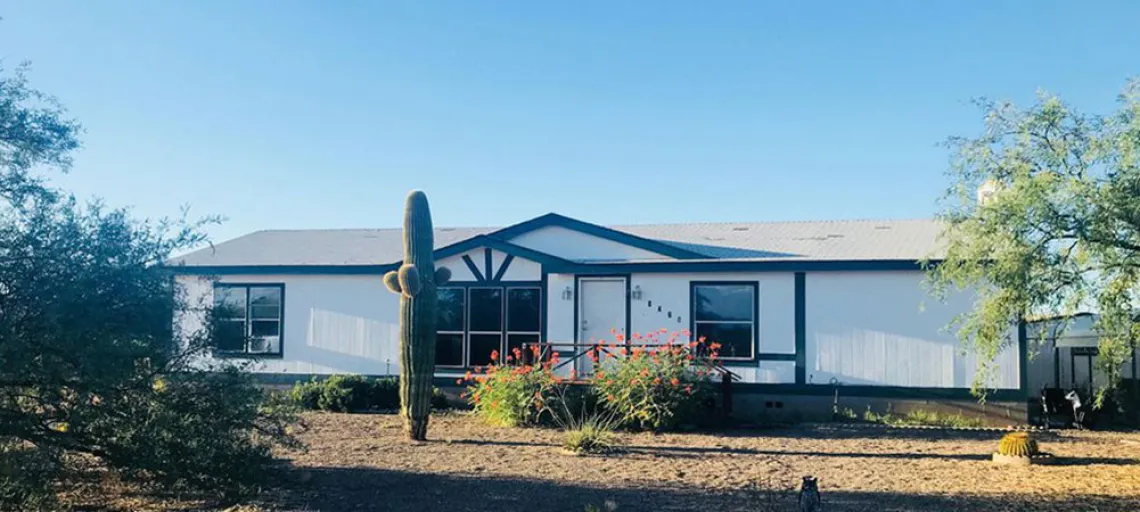The Manufactured Housing Gap in Tucson and Pima County
UA MAP Dashboard examines manufactured housing’s promise vs. experience as affordable option in metro Tucson.

TUCSON, Ariz. (August 20, 2019) -- Manufactured housing is an important source of good quality, affordable housing in Tucson and Pima County, but often fails to live up to its potential for many residents, according to research by the University of Arizona (UA) School of Geography and Development.
“The ‘Manufactured-Housing Gap’ in Tucson and Pima County: Introduction and Preliminary Analysis” outlines the unique social, financial and environmental factors that can make manufactured housing more insecure than other forms of housing. The report also suggests ways that manufactured housing, which is experiencing renewed interest due to affordable housing shortages, can provide better quality of life for more people in Tucson and other cities.
Metro Tucson, one of the poorest large cities in the US, ranks 295th in income per person among the 383 census metropolitan areas. This means that to control housing cost burdens in the city it is important to preserve and improve existing stocks of lower-cost housing. Although manufactured housing is one of the city’s most prevalent affordable housing options, according to the authors, “there is often a wide gap between the merits and promise of manufactured housing in theory, and how manufactured housing is lived in and experienced by residents, or perceived by the general public, government agencies and politicians”. The researchers call this mismatch between the promise of manufacture housing, and how it is experienced and perceived the “manufactured housing gap”.
In the report, the research team identify areas of the city where this “manufactured housing gap” is likely to be the widest based on key social and economic indicators. The areas identified in the report, places where concentrations of manufactured housing and socio-economic insecurity overlap the most, are the Flowing Wells area, the Benson Highway area, and the area between Interstate 19 and South Mission Road.
Among the findings:
- Manufactured housing residents often face unique social, financial and environmental vulnerabilities. These are especially important to understand in metro Tucson, where roughly 10 percent of all housing units are mobile/manufactured homes. This is more than twice the percentage found in other Western US cities; for example, Phoenix is 4.8 percent, Las Vegas is 3.3 percent., Portland is 4.4 percent and Los Angeles is 1.6 percent.
- Thirty-five percent of Pima County’s manufactured-housing stock is pre-1976. These older homes were typically built with hazardous materials like asbestos and formaldehyde, poor insulation, which leads to higher utility bills, and fire-prone aluminum wiring.
- Divided ownership structures – where manufactured-housing residents might own their unit but rent the land on which it sits – make those residents particularly vulnerable to rent increases and eviction.
- Stigmas and stereotypes about manufactured housing have played a central role in shaping its present geography.
- Research has found no evidence to support popular assumptions that manufactured-housing communities increase violent or property crime in surrounding communities. Some types of crime may actually be lower than in comparable site‐built housing developments, research suggests.
The UA team emphasizes the importance of not presupposing the marginality of manufactured housing and those who call it home. The authors hope to shift public discourse about manufactured housing from a focus on problems to programs and policies that can close the manufactured housing gap. Ultimately, their goal is to provide the research insight necessary to improve quality of life in Tucson’s manufactured housing communities.
With this goal of closing the manufactured housing gap, the UA team, with the support of the Haury Program in Environment and Social Justice, has partnered with Habitat for Humanity Tucson and the City of Tucson’s Ward 3 and Ward 6 Council Offices, to directly engage communities about quality of life. Manufactured housing residents, community managers and owners interested in participating in this research should contact Dr. Mark Kear (520-621-1021 or mkear@email.arizona.edu).
The UA white paper was authored by Mark Kear, Assistant Professor in the UA School of Geography and Development; Taylor Handschuh, UA School of Geography and Development; Sarah Launius, aide in the Tucson City Council Ward 3 Office; Julian Hartman, doctoral student in Geography and Development; Dugan Meyer, doctoral student in Geography and Development; and Gary Christopherson, UA Associate Professor of Practice and Director of the Center for Applied Spatial Analysis, School of Geography and Development.
About MAP DASHBOARD MAP – Making Action Possible for Southern Arizona, and referred to as the MAP Dashboard, is a partnership with the University of Arizona Eller College; the Community Foundation for Southern Arizona (CFSA; the Pima Association of Governments; Sun Corridor, Inc.; and the Southern Arizona Leadership Council (SALC). The MAP Dashboard Project was created to measurably improve Southern Arizona through data-driven collective civic action and education. The University of Arizona’s Eller Economic and Business Research Center has built the MAP Dashboard and will keep the information up to date. The MAP Dashboard Project provides our region’s first common set of indicators in a single, easy-to-access source of reliable information. That information is available at www.mapazdashboard.arizona.edu

